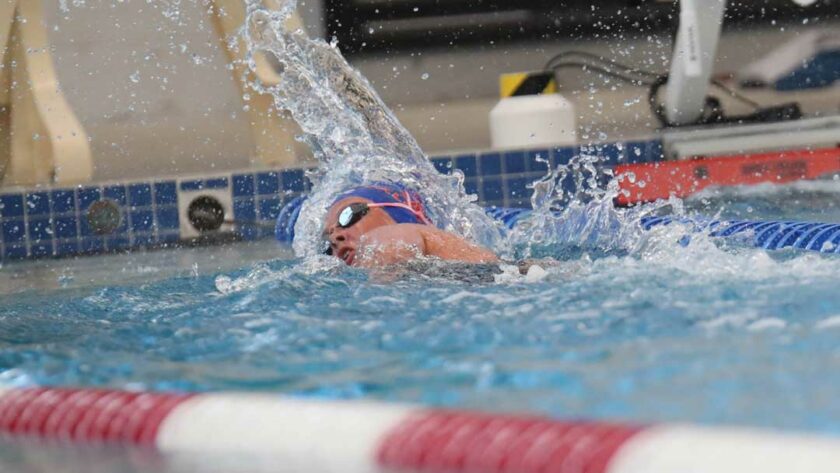Your swimmer starts the season strong—then shoulder pain hits. Swimmer injury prevention is key to keeping them in the water.
Swimmer Injury Prevention Tips for a Strong, Healthy Season
As a former competitive swimmer and current swim mom, I know how quickly excitement can turn into worry. Injuries don’t just slow swimmers down—they stress out the whole family.
Thankfully, swimmer injury prevention doesn’t have to be complicated. With a few smart habits, you can help your athlete stay strong, confident, and in the pool all season long.
Understanding Common Swim Injuries
Swimming may be low-impact, but it’s not injury-proof. Repetitive motion puts constant stress on growing bodies.
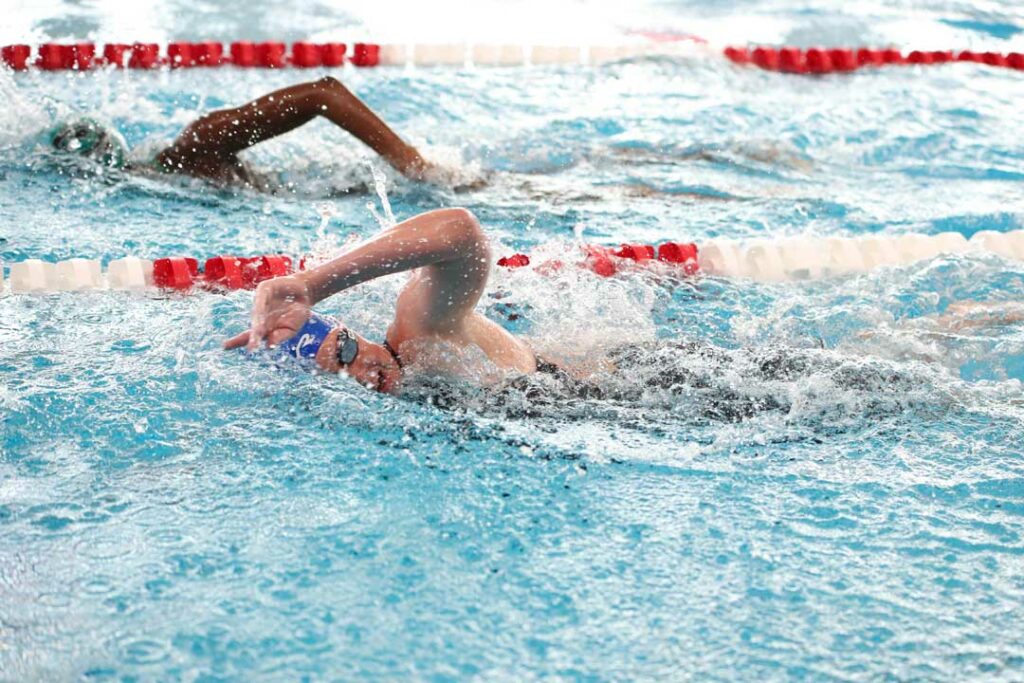
Without proper care, that stress can lead to overuse injuries—especially in competitive swimmers.
These are the most common injuries I see on deck:
Swimmer’s Shoulder
This is the big one. Swimmer’s shoulder refers to inflammation in the rotator cuff or biceps tendon. It’s caused by poor technique, fatigue, or overuse during high-volume training. It often starts as mild soreness, then progresses into sharp pain with movement.
Knee Issues
Knees take a beating in breaststroke. “Breaststroker’s knee” is a real thing—usually caused by improper kick mechanics or tight hips. Watch for swelling or complaints of pain during kick sets.
Lower Back Strain
Flip turns, dolphin kicks, and even long practices in streamline position can strain the lower back. Poor core strength or exaggerated arching makes it worse.
Neck and Spine Stress
Long freestyle sets and poor breathing technique can cause neck pain and spinal misalignment. Over-rotating or breathing on one side only adds to the problem.
While these injuries are common, they’re not inevitable. With proper stroke mechanics, rest, and body awareness, most can be avoided. That’s why swimmer injury prevention starts with understanding the risks—and addressing them early.
Why Injury Prevention Matters for Youth Swimmers
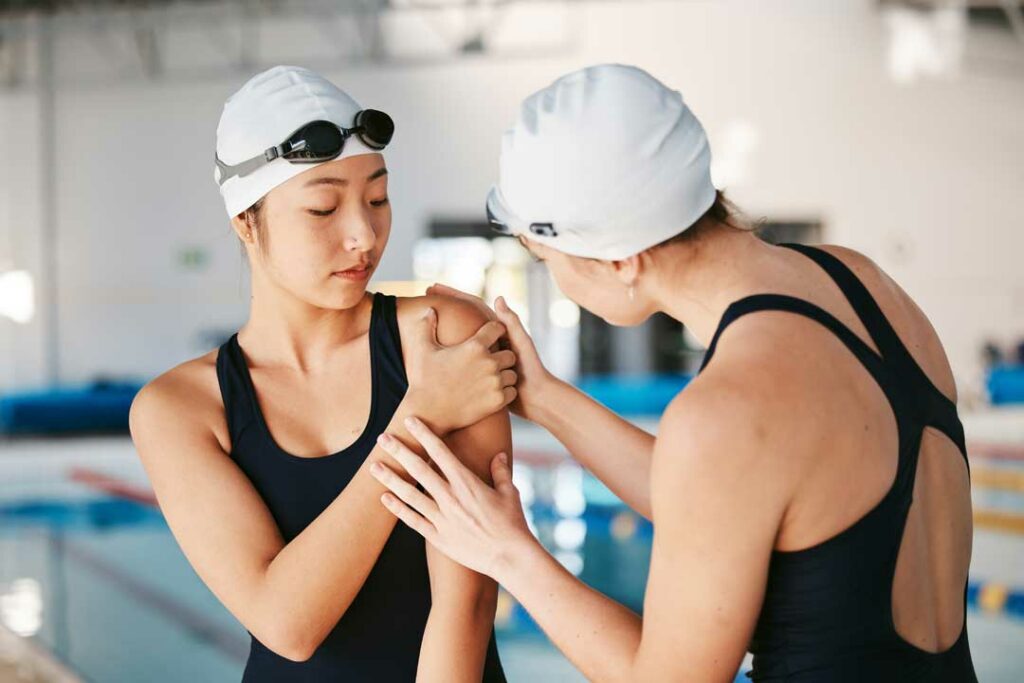
Youth swimmers aren’t just mini adults in the pool. Their bodies are still growing, which makes them more vulnerable to stress and overuse. What might be a minor ache for an adult can quickly become a more serious issue for a developing athlete.
If injuries go unmanaged, they don’t just delay progress—they can cause long-term problems. Chronic pain, joint instability, and even permanent damage can result from pushing through pain without proper care.
Injury setbacks can also chip away at confidence. Your swimmer might start second-guessing their abilities or lose motivation entirely. That mental toll is just as hard to recover from as the physical one.
As a swim mom, I know how hard it is to watch your child miss out on the sport they love. We want to protect their passion, not pause it. That’s why swimmer injury prevention isn’t just a checklist—it’s part of being a good swim parent.
Building a Solid Injury Prevention Plan
Injury prevention isn’t one big thing—it’s a series of small, consistent choices. The good news?
Most of them are simple and easy to implement.
As a swim mom, I’ve found these habits make a huge difference over the course of a season.
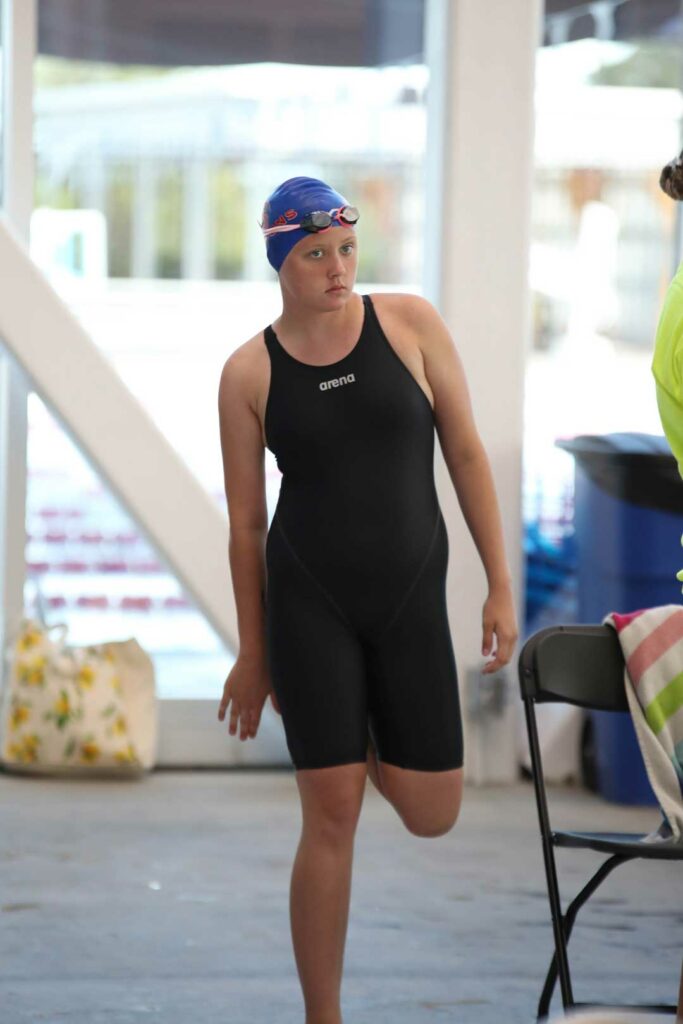
Proper Warm-Ups and Cool-Downs
Every swim should start and end with intention. Before practice, dynamic dryland stretches like arm circles, jumping jacks, and leg swings help activate muscles safely. A quick five minutes makes a big impact.
After practice, cool-down laps flush out lactic acid. Follow it up with gentle stretches to help muscles recover faster and reduce stiffness.
Cross-Training to Support Muscle Balance
Swimming works the same muscle groups over and over. That’s why cross-training is so helpful. Activities like yoga, resistance bands, or light running build strength and balance throughout the body.
Mixing it up prevents overuse injuries and helps young athletes develop as well-rounded movers. Even just a weekly change can support long-term swimmer injury prevention.
Prioritizing Technique
Technique matters more than volume. A swimmer doing 5,000 yards with poor form is at far greater risk of injury than one swimming 2,000 yards with perfect technique.
Ask your swimmer’s coach about stroke assessments. Video analysis can reveal subtle habits that may lead to trouble later. Small adjustments now can save months of pain and missed meets later.
Rest and Recovery
Rest is just as important as practice. Overtraining can sneak in quietly—especially during growth spurts. Look for signs like mood swings, increased soreness, and poor sleep.
Support recovery with early bedtimes, solid meals, and hydration. I also recommend exploring chiropractic care, especially during heavy training blocks. Gentle adjustments can improve mobility, reduce tension, and help growing swimmers stay aligned.
Smart Scheduling
We want our kids to chase big goals, but even swimmers need downtime. Back-to-back meets, extra clinics, and other sports can pile on fast.
Protect your swimmer’s schedule like you would a family budget. Leave room for rest. Watch for signs of burnout—like dread before practice or declining performance. Sometimes skipping a meet is the smartest move of the season.
Supporting Your Swimmer from the Sidelines
As swim parents, we’re not just chauffeurs and snack packers—we’re also our swimmer’s first line of support. Injury prevention doesn’t stop at the pool deck. It starts with what we notice (and what they might not say).
Kids don’t always speak up when something hurts. They may push through pain to avoid missing a meet or disappointing their coach. That’s why open communication is so important. Let your swimmer know they can talk to you—without judgment—about how their body feels.
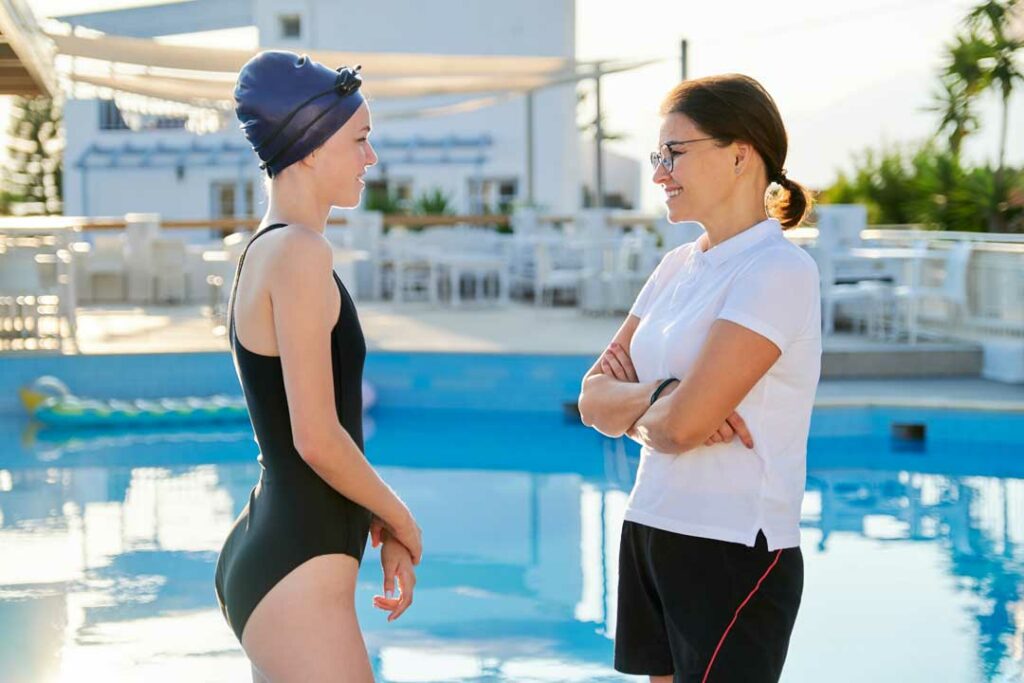
Watch for the little signs. A drop in performance, uncharacteristic mood swings, or constant soreness can be quiet red flags. Trust your gut. You know your kid better than anyone.
Don’t hesitate to schedule a check-in with a sports physical therapist or pediatrician—especially if something feels off. A quick evaluation now can prevent a long recovery later.
Being present, observant, and supportive is a huge part of swimmer injury prevention. You’re not being overprotective—you’re being proactive. And that’s one of the most powerful roles a swim mom (or dad) can play.
Must-Have Gear That Supports Injury Prevention
The right gear doesn’t just improve performance—it also protects your swimmer’s body. When used correctly, it can reduce strain, improve form, and make a big difference over the course of a season.
Fins help reinforce proper kick technique while reducing shoulder stress during long sets. Paddles, when sized appropriately and used under coach supervision, can build strength without overloading small joints. Kickboards and pull buoys are great tools—but using them with poor form can actually cause problems. Make sure your swimmer understands how and when to use each piece of gear.
Snorkels are a secret weapon for swimmer injury prevention. They eliminate the need for constant head turning, giving the neck and spine a much-needed break during drills and technique work.
Don’t overlook the basics either. A well-fitted suit offers the right compression without restricting movement. Goggles that don’t leak or dig into the eye sockets help swimmers stay focused—without the constant distraction of discomfort.
At home, tools like a foam roller or massage gun can help speed up recovery and ease tight muscles. Even five minutes of post-practice rolling can prevent soreness from turning into something more serious.
When it comes to gear, a few smart choices go a long way in keeping your swimmer strong, aligned, and injury-free.
When to Seek Professional Help
Not all pain is just “part of the sport.” Knowing the difference between normal soreness and a real injury is essential for swimmer injury prevention.
It’s normal for swimmers to feel tired or achy after a tough set. But sharp, lingering, or one-sided pain isn’t something to ignore. If your swimmer avoids certain strokes, starts compensating with poor form, or complains of pain that doesn’t go away with rest—those are red flags.
Swelling, reduced range of motion, or pain that worsens with activity are all signs it’s time to stop and get evaluated. Don’t wait for things to “just get better.”
Trust your instincts. If something feels off, it probably is. Reach out to a sports physical therapist, pediatric orthopedist, or other specialist who understands youth athletes.
There’s no prize for pushing through pain. Early treatment often means faster healing—and fewer missed practices in the long run. As swim parents, our job isn’t to toughen them up. It’s to protect their health and passion for the sport.
Final Thoughts: Prevention is a Team Sport
Swimmer injury prevention isn’t a solo effort. It’s a team approach—one that includes your athlete, their coach, and you.
When everyone communicates, stays consistent, and puts long-term health first, your swimmer has the best chance to thrive. Injuries may still happen, but with care and attention, they become the exception—not the rule.
As a swim mom, I’ve learned that showing up, speaking up, and staying involved makes all the difference. Together, we can help our swimmers stay strong, confident, and in love with the sport they work so hard for.
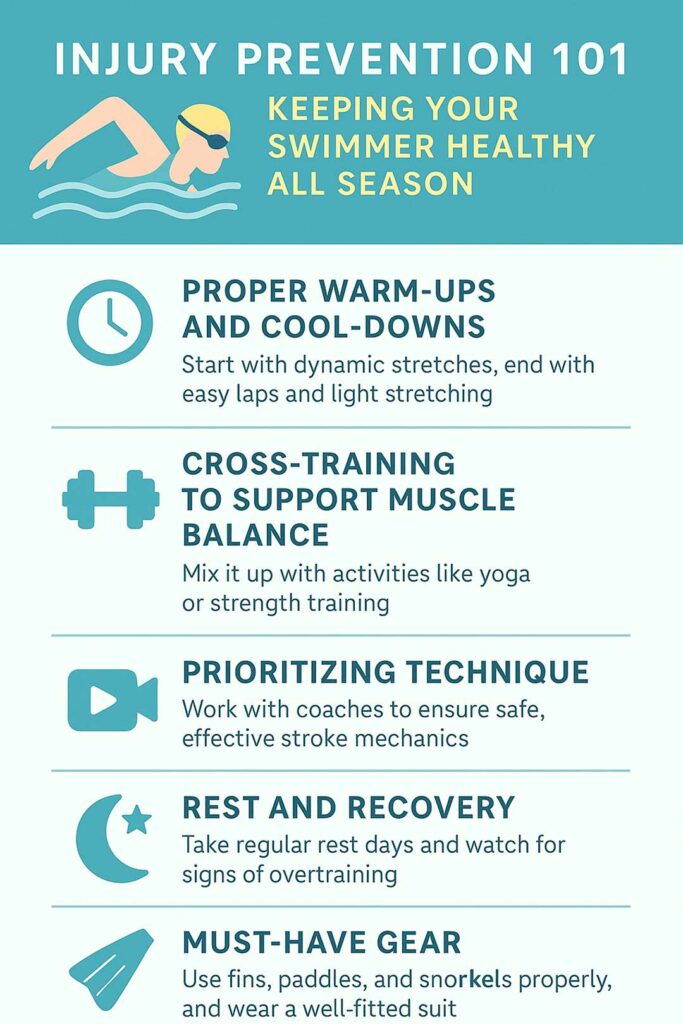
Have a go-to recovery tip or injury prevention hack that’s helped your swimmer? Share it in the comments—we’re stronger together!
FAQs: Swimmer Injury Prevention
Swimmer’s shoulder is the most common injury. It’s caused by overuse, poor technique, or training without proper recovery.
Watch for constant fatigue, mood swings, poor sleep, and declining performance. If rest doesn’t help, talk to a professional.
Focus on lean protein, complex carbs, and hydration. Post-practice snacks like chocolate milk or Greek yogurt can speed up recovery.
At least one full rest day per week is ideal. Add more during growth spurts, heavy training weeks, or after big meets.
Tech suits aren’t harmful when used correctly, but they shouldn’t replace proper strength, technique, or training. Save them for championship meets.

